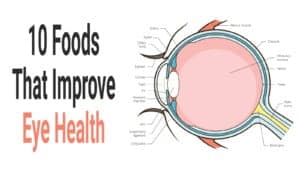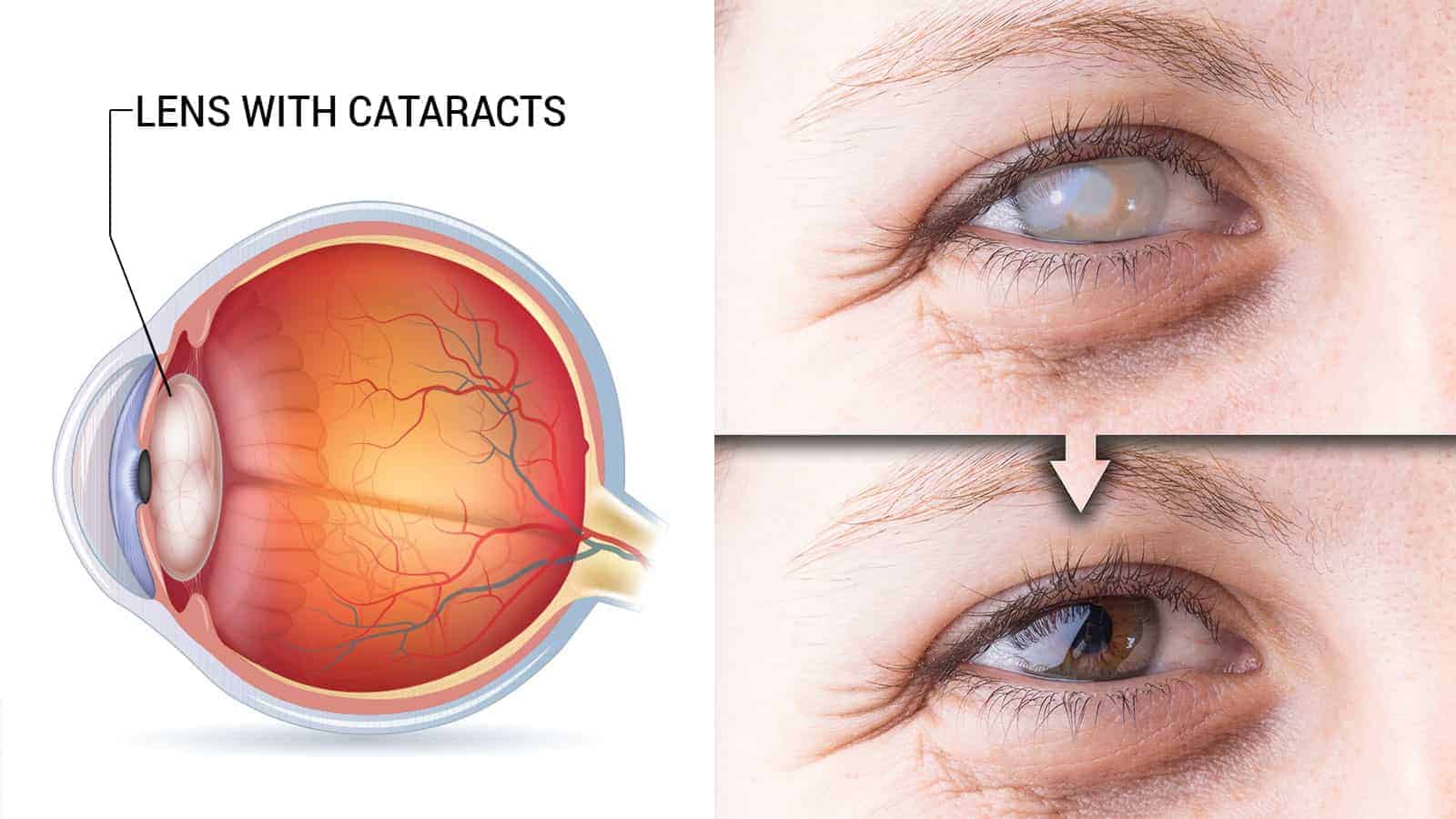Cataracts are the world’s most common age of vision loss. In this condition, the lens of the eye becomes cloudy, so light does not pass through it properly.
There are at least three types of cataracts, and they differ by the part of the lens from which they originate. They also have somewhat different symptoms and causes. A nuclear cataract, for example, develops in the nucleus or central area of the lens. A cortical cataract forms in the cortex surrounding the nucleus. A subcapsular cataract originates in the back of the lens, and it tends to progress more quickly than the other types.
Causes of Cataracts
1. Aging
Many people find their vision declines as they get older. For example, the lens of the eye gets stiffer and less able to adjust to changes in distance, which is why people often need reading glasses after the age of 40. Similarly, people become more likely to develop clouded lenses after they reach 60.
The lens of the eye is comprised mainly of water and protein, and the protein is arranged in a pattern to keep the area clear. As a person ages, however, the protein starts to clump together, and those clumps cause the lens to become cloudy.
2. Birth Defect
Some patients are either born with cataracts or develop them in early childhood. These conditions may have a genetic cause, or they may stem from an injury or infection that occurred in the womb. Known causes of congenital disabilities affecting the lens include rubella, galactosemia, myotonic dystrophy, and neurofibromatosis type 2.
3. Use of Steroid Medications
Researchers have established that high doses of oral corticosteroids can increase the risk of damage to the lens – and some fear that lower doses may not be risk-free.
In 2006, the European Respiratory Journal described a study in which scientists researched the risk of using nasal corticosteroids. The scientists collected data from Quebecois medical records that covered the years 1988 to 2001. They examined the records of patients who were at least 65 years old and took nasal corticosteroids to treat upper respiratory conditions. These patients included those who were either diagnosed with a cataract or had surgery within four years of using the corticosteroids. They described a patient as having “severe cataracts” if they needed surgery within two years after diagnosis. The researchers only considered patients who had never developed the condition.
The scientists examined the records of 101,850 patients and found that 27,708 had either been diagnosed with clouded lenses or undergone cataract surgery. Of that group, 10,754 had had severe cases.
The researchers found that patients who utilized nasal corticosteroids were more susceptible, and that risk increased with larger doses.
4. Diabetes
There are two primary classifications of diabetes, Type 1 and Type 2. In Type 1 diabetes, the pancreas doesn’t produce any insulin. In Type 2 diabetes, the pancreas does not make sufficient insulin for the body, or the body doesn’t respond to it. Both types result in abnormally high blood sugar or glucose levels.
The aqueous humor, which is the liquid in the front of the eye, transports glucose, and oxygen to the lens. Abnormally high amounts of glucose can make the lens swell. The lens also contains an enzyme that converts glucose into a substance called sorbitol. Too much sorbitol affects the proteins and other cells in the lens and can cause the lens to become increasingly opaque. The patient thus eventually develops a cataract.
Patients with diabetes are not only more susceptible to cataracts, but they are also more likely to develop eye problems at a younger age than non-diabetics. Even worse, their eyes will probably deteriorate more quickly.
5. Ultraviolet Rays
Not only do ultraviolet rays damage the skin, but they can also harm the lens of the eyes. Scientists have been trying to unravel this out for years. The National Eye Institute funded a study asking that question in 2014.
Scientists know that oxidative stress causes or contribute to both aging and age-related diseases. The oldest parts of the lens, however, get little oxygen, so they should not be susceptible to oxidative stress. Yet a cataract can still develop in those parts of the lens.
Researchers at Case Western Reserve University, located in Cleveland, Ohio, conducted experiments in which they exposed the chemicals and proteins found in the lens to UVA rays. They discovered that UVA rays could damage the proteins in the lens in the same way that oxidation stress does. That damage caused the lens of the eye to become cloudy.
Symptoms of Cataracts
1. Blurry Vision
A cataract is among the many eye conditions that cause blurry vision. In fact, blurry vision is one of the first symptoms that the patient notices. Some patients have described the state as being similar to looking through a fogged window or frosted glass. For example, while they can see somebody standing in front of them, they may have trouble making out that person’s facial features.
2. Increasing Difficulty Seeing at Night
A clouded lens will impair the patient’s night vision. That can make it increasingly difficult to do things like go driving at night.
In 2010, researchers associated with the Curtin University in Australia conducted a study on the impact of cataract surgery on the rate of car crashes. They studied the records of 27,287 residents of West Australia who had had cataract surgery between 1997 and 2006. 1715 of the residents had been involved in 1762 accidents during that time.
The researchers found that surgery reduced the risk of crashing by nearly 13 percent. The researchers hoped their results would reduce the wait time between a diagnosis of cataract and surgery. At the time of the study, patients could wait weeks or even months after diagnosis to have their defectives lenses removed.
 3. Seeing Halos around Lights
3. Seeing Halos around Lights
A halo is a bright ring around a light source, such as a car’s headlights. People are most likely to see halos in dim or dark places or at night. While people with healthy eyes may see halos, they often indicate an eye problem. This is especially true if the halos appear suddenly or accompany symptoms like blurry vision or pain.
The journal Applied Ergonomics published a 2009 study in which researchers used a new device called the Halometer DG to test the visual acuity of older adults who drove. One group had cataracts, and the other did not. The scientists exposed the volunteers to a device that created halos and had the Halometer DG measure the effects on their eyes. The volunteers also filled out a questionnaire about their driving habits. The scientists found that the subjects with clouded lenses were more likely to see halos and glare and that they were more likely to have trouble driving at night and in other challenging conditions.
4. Double Vision
Double vision or diplopia describes a state in which the patient sees two separate or overlapping images of a single object. In some cases, one copy is hazier than the other, creating a condition called “ghost image.” Double vision can be horizontal or vertical.
Some people develop double vision after drinking too much or if they’re exhausted. This type of double vision is typical and goes away after sobering up or getting proper rest. Persistent or recurring double vision, on the other hand, can indicate problems with the eyes or nervous system. A patient with cataracts, for example, is particularly likely to develop a type of diplopia called “monocular double vision,” in which the patient still sees double after closing one of their eyes.
5. Changes in Color Perception
A patient with clouded lenses will gradually perceive colors less intensely. Colors will appear faded or even yellowed. This symptom is particularly common in people with nuclear cataracts, for the lens in their eye may turn yellow or even brown. That discoloration increasingly impairs the patient’s ability to distinguish colors.
6. Sensitivity to Light and Glare
Sensitivity to light is a common symptom. A patient with a subcapsular cataract is especially likely to find bright light painful.
7. Second Sight
Second sight is a symptom seen in patients who develop nuclear cataracts. A patient with second sight finds that their near vision has improved. Unfortunately, as the cataract develops, that improvement turns out to be temporary.
8. Spokes in the Eye
A patient with a cortical cataract will form what looks like white wedges that appear on the edges of the lens and gradually extend toward the center.
 Final Thoughts on Cataracts and Your Vision
Final Thoughts on Cataracts and Your Vision
Researchers still question whether cataracts are wholly preventable since they commonly stem from the aging process. Other risk factors, however, include previous surgery or injury to the eye, alcoholism, obesity, and smoking. You can control some of these, and you can also limit your exposure to UV rays. While you probably can’t prevent the development of cataracts altogether, you can reduce your risk.
Eye surgeons often resolve cataracts through surgery. In the process, the doctor removes the cataract and replaces it with an artificial lens called an intraocular lens (IOL). The procedure takes around 15 minutes per eye. Cataract surgery is prevalent. Indeed, over three million people in the US undergo cataract surgery every year.















 Community
Community

